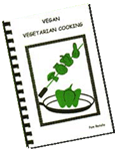
VeggieCooking.com
Vegan Cookbook
Vegan Recipes
Vegetarian Recipes
Donate!
Featured Articles:
My Vegetarian Cookbook Index
Healthy Eating
The Genetic Fad - A Medical Myth
Joel Wallach - Copper Deficiencies
Lawrence Broxmeyer - Mad Cow
Organophosphates - Mad Cow
Multiple Sclerosis and Mercury
Alternative Medicine Used for Flus
Good Fats (Omega-3 Fatty Acids)
Dr. Hulda Clark - Cancer and AIDs
Alternative Cancer Treatments
Vegans and Vitamin B-12
Aspartame, MSG - Excitotoxins
Sickle Cell Anemia
Jake Beason - Raising Children
Election Fraud 2004
9-11: A Government Operation
Pam Remembers Ronald Reagan
Family Values
Giving Thanks
Travel Page
Photo Gallery Main Page
The Peace (Flower) Gallery
Glacier National Park Gallery
Autumn Foliage Gallery
2004 New York City Protests
Yellowstone National Park Gallery
The Badlands Photo Gallery
Luray Caverns in Virginia
Shenandoah Caverns in Virginia
Skyline Caverns in Virginia
Endless Caverns in Virginia
Dixie Caverns in Virginia
Natural Bridge in Virginia
Crystal Caverns at Hupp Hill in Virginia
Cave of the Mounds in Wisconsin
Kickapoo Indian Caverns in Wisconsin
Crystal Cave in Wisconsin
Niagara Cave in Minnesota
Mena Airport Photo Gallery
Skyline Drive Photo Gallery
The House on the Rock Gallery
Wisconsin Windmill Farm
Copyright Notice & Limited Use
Other Health Web Sites:
Mercury Poisoned .com
Cancer Tutor .com
Dorway.com - Aspartame
Breast Implant Dangers
Dr. Hulda Clark - products
Dr. Clark Information Center
Dr. Joel Wallach
Dr. Lawrence Broxmeyer
Mark Purdey
Dr. Joseph Mercola
Dr. Hal Huggins
Dr. Lorainne Day
Dr. Andrew Weil
Dr. Ralph Moss - Cancer Decisions
Dr. Patrick Flanagan - Neurophone
NUCCA-Certified Chiropractors
Pranic Healing
Alternative News Sites:
Rense.com
What Really Happened .com
Buzz Flash .com
Information Clearing House
Prison Planet.com
Alternative Radio:
WBAI - New York City
KPFK - Los Angeles
KPFA - Berkeley
WPFW - Washington, DC
Air America Radio
PamRotella.com
Disclaimer: This information is for educational purposes only,
and does not replace individualized diagnosis and care.
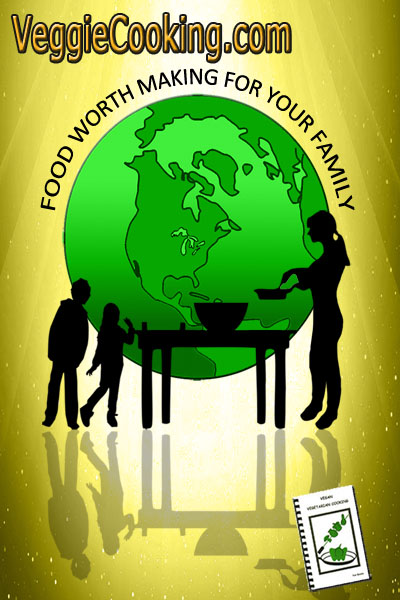 Healthy eating: How my book measures up to the major theories
Healthy eating: How my book measures up to the major theories
[Posted 23 May 2004]
The vegetarian, and especially vegan, diet is widely acclaimed for its health benefits. My book is considered to be one of the healthier vegan cookbooks because it's also primarily a whole foods cookbook. However, there are a number of valid health considerations and theories about any type of food, as well as the issue of health standards changing through time, with foods once considered healthy falling out of favor. In this article, I want to explore how my book measures up to today's major theories on healthy eating.
I tried to avoid including health information in my cookbook, as I didn't want to commence on a major research project at the time. It was difficult enough for me to put together a cookbook with my working schedule, and I didn't want information that could easily become outdated. This is also one of the reasons that brand-name ingredients were avoided. I wanted the book to be just as valid for a grandchild finding it in a grandparent's attic 50 years from now as it was for the grandparent today. Nevertheless, for this article, I thought it'd be interesting to compare how my book stacks up to major health authors and theories of today.
The good-fat, bad-fat issue
When I started writing the cookbook in 1997, information on good fats and bad fats wasn't as widely available as today. Thankfully, I recommended extra virgin olive oil as the cooking oil for all of my recipes, and it turns out that the high oleic acid content (a "good fat" -- Omega-9 fatty acid) in olive oil makes it very stable during cooking. Some recommend extra virgin olive oil as the only oil to use for cooking. Oils with Omega-3 fatty acids, such as Canola, don't withstand heat well, and cooking oils high in Omega-6 fatty acids usually have a low quality of Omega-6. Also, the American diet is considered to be too high in Omega-6 fatty acids, and too low in Omega-3 and -9 fatty acids.
Extra-virgin olive oil comes from the first cold pressing of olives, which means that high heat and chemicals weren't used to extract it. To be certified as extra-virgin, olive oil must pass tests for low acidity and taste. I find the taste of extra-virgin olive oil adds character to the flavor of any dish, and makes the dish seem less heavy and greasy-tasting.
While writing the book, I was already aware of the controversy over hydrogenated oils, such as those found in margarine and solid vegetable shortenings. All hydrogenated oils were avoided in my book -- the only added fat was extra-virgin olive oil or the natural fats found in nuts, seeds, avocados, and olives. Even the pie crust is made with extra-virgin olive oil.
It's also considered healthier to work "good fats" into the diet in their natural foods, like walnuts, avocados, olives, etc., as healthy fats stay in the blood longer than when obtained by supplementing with flaxseed or other healthy oil blends. Many of the recipes in my book include healthy fat sources such as nuts, seeds, avocados, and olives. I also tried to use a variety of these healthy fat sources, so that almost every type of nut and seed has a place in the book. Very few cookbooks can match the variety of foods used in my book.
I did use sauteeing as a method of cooking for quite a few dishes, which does add fat to a dish. For those trying to avoid as much fat as possible, particularly heated oil, those recipes could be avoided. However, I don't believe in total fat-free eating, and find that sauteeing allows the cook at least some freedom to determine the final consistency (crunchy or soft) of their vegetables.
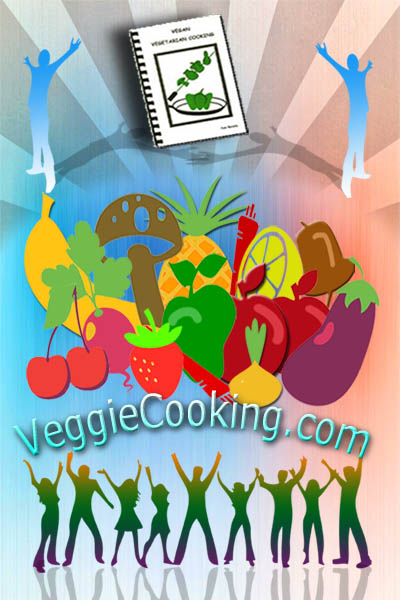 Sugar and sweets
Sugar and sweets
I went out of my way to avoid using refined sugar in the book, and included very few desserts -- just a few fruit pies. Personally, I don't eat sweets often, and try to avoid serving them to others. (According to Dr. Joel Wallach, cravings for sweets or salt indicates a mineral deficiency.) So any book coming from me won't include a lot of desserts or sugar.
When necessary, sweetening in my book was done with fruits and vegetables, for example the pumpkin pie is sweetened with yams or sweet potatoes, the pecan pie is sweetened with persimmons, and the BBQ sauce and "steak" sauce were sweetened with blended raisins. This is very unusual for any cookbook, even whole foods cookbooks. Many other foods are naturally sweet and don't need anything extra. I thought it was important to use only whole foods for sweetening in cooking. The main issue with refined sugars is that they're so pure that they have no nutrients of their own, other than calories, and the body actually needs to take nutrients away from other food in order to digest them. There's also a well-established link between refined sugar diets and arteriosclerosis/heart disease.
Soy, Tofu, wheat gluten, and other imitation meat products
Most people would expect a vegetarian cookbook to contain a lot of tofu and other soy products. Some vegetarian cookbooks are nothing more than meat- and dairy-based recipes, with imitation meat and cheese products replacing the meat and cheese. Certainly, a vegetarian cookbook isn't needed for something so ordinary. When I wrote the book, I rarely ate tofu or other imitation meat or cheese products simply because I didn't like them. I'd grown tired of tofu after the first 2 years of going vegetarian, back in the 1980s. I was sure that most long-time vegetarians would face the same ordeal, and wanted to stay away from imitation meat products. Also, most imitation meat and cheese products weren't very good back in '97 when the book was written. Since then, imitation meat products have become more widely available and better in texture and flavor, but not without controversy.
Soy is controversial even without processing it into tofu or other products. There were some now-discredited studies claiming that the plant estrogens in soy helped prevent breast cancer, or helped with menopausal symptoms. However, later studies by different funding sources found that soy actually increased the risk of cancer, and the isoflavones and plant estrogens in soy can also upset menstrual cycles, affect brain development in male children, and create other health problems. Another issue is the rejection of soy by some FDA scientists as a food, because it wasn't found to be safe in any quantity.
Wheat gluten is the protein found in wheat, another substance commonly used in imitation meat products. Some claim that wheat gluten clogs the islets of Langerhans in the pancreas and plays a role in diabetes. Some have allergies to wheat gluten, and need their food be gluten-free.
Another issue in processed food of any kind, especially imitation meat products, is chemical and animal ingredients. Sometimes imitation cheese products include whey or other dairy products -- in other words, the "imitation" cheese actually is a dairy product. Even worse, often the dairy product used is casein, a protein used in some glues, and the main culprit for people with problems digesting dairy products or problems absorbing nutrients due to dairy products coating the intestines. Another problem ingredient is MSG and MSG-like substances, such as hydrolyzed vegetable protein -- chemical ingredients that most people want to avoid due to potential brain and nervous system damage. Often imitation meat products contain the same suspect wording used to disguise MSG in other products, such as "spices" and "natural flavorings". There's no way to tell if any of the imitation meat and cheese products contain MSG when such "MSG code words" are used. As a general rule, if I don't know what each substance on an ingredient label is, and am sure about what it does to the body's health, then I try to avoid it.
In my book, I offer a few "imitation meat" recipes that can be made with whole foods (Lentil Loaf, Chick Pea Loaf, Beanburgers etc.), although as a rule I prefer not to concentrate on imitating meat and cheese. (Hummus is also good as a cheese substitute.) To me, imitation meat helps previous meat eaters replace their old favorites with something similar, but I think it's better that people develop new non-meat favorites in place of the old. Best of all, my book avoids the controversies surrounding soy, wheat gluten, and added chemicals found in most prepared imitation meat and cheese products. That's one advantage that most whole foods cookbooks can offer.
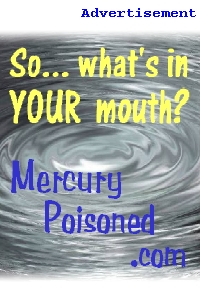 Water
Water
This is one area where I've changed my mind since publication. One thing I recommended in my book was distilled water. It does make food taste better, and was promoted by the book Fit for Life, which documented what I still consider to be one of the healthiest ways of eating. However, there is a controversy surrounding water that is bottled and sold, rather than filtered or distilled from the tap. Namely, chemicals used to clean the bottle prior to packaging, and chemicals leached from the bottle's plastic after packaging, are considered to be unhealthy. Since writing the book, I've decided against recommending distilled water, or any other kind of water. Filtered or distilled water does make the food taste better, but I'll leave water purification decisions up to the reader.
Cooked food vs. raw food
My cookbook isn't a raw foods cookbook, although it does have several raw foods recipes and I do agree that a vegan raw foods diet is healthier than a vegan cooked foods diet. I was raised on a mixture of both raw and cooked foods, and still prefer to have at least some warm meals. My book was written for people like myself, who still prefer at least some cooked meals. There are other authors offering 100% raw foods cookbooks, for those readers who have moved on to an even healthier way of eating.
Proper food combining, Fit for Life, and Natural Hygiene
The first customer comment I received on the cookbook was from a health food store owner in Iowa. She wanted to know why I'd mention Fit for Life at the outset of my book, but then not properly combine all of my recipes according to Natural Hygiene. Although I mention the book Fit for Life at the start of my cookbook, only some of my recipes are properly combined. This is because I personally don't always follow proper food combining, and with a vegan diet there isn't much of a drop in energy after meals anyway. Although I do agree that "natural hygiene" is probably the ideal way to eat, it's difficult to follow all of the time, and I rarely consider it when developing new recipes.
For example, proper food combining means that nuts can't be mixed in with fruits in salads, or mixed with much of anything else. I think it's important to use nuts and seeds in dishes. Also with natural hygiene, nothing but fresh fruit can be eaten before noon, and then each type eaten separately 15-30 minutes apart. Personally, I often prefer a warm breakfast, such as potatoes or oatmeal. A tomato shouldn't ever be cooked according to natural hygiene, because cooking makes the tomato acidic, and so on. Obviously, it's difficult for any American to eat this way all the time. Not ever cook a tomato? There goes pizza, tomato soup, spaghetti sauce, and so many of our other favorite dishes. As with a raw foods diet, also recommended by Fit for Life, I'm not ready for proper food combining 100% of the time, and people looking for "properly combined" recipes would find better value from cookbooks dedicated to that subject, possibly the book Fit for Life itself and its later versions. Note that the book seller I use on VeggieCooking.com is an author himself, and he offers several publications on proper food combining.
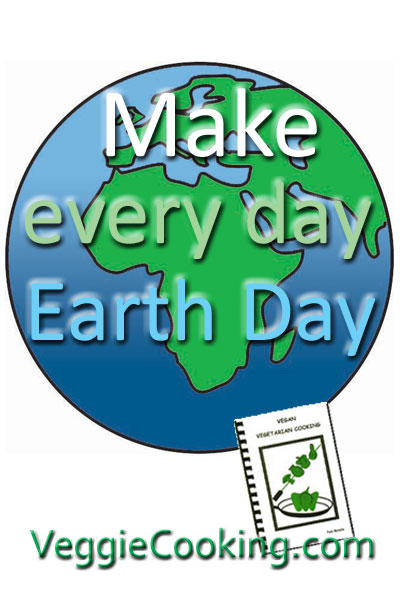 Excitotoxins - MSG, Aspartame, Hydrolyzed Vegetable Protein, etc.
Excitotoxins - MSG, Aspartame, Hydrolyzed Vegetable Protein, etc.
One way to avoid the MSG frequently found in processed or restaurant food is to cook for yourself at home. This is especially important while MSG and other excitotoxins continue to be unregulated in most foods. MSG has been shown to cause brain damage in children, and can gradually damage adult brains until diseases such as Alzheimer's and Parkinson's develop. This is of especial concern as more families resort to packaged and restaurant food in order to save time while feeding their families. Any whole foods cookbook, which starts from fresh ingredients without added chemicals, allows people to avoid all MSG in their food prepared at home.
Dr. Hulda Clark's protocols
Hulda Clark is the famous and tireless Canadian research scientist, internationally known for her tremendous contributions to electronic and alternative medicine. Her books have sold millions of copies, with her cancer and AIDS cures so effective that the American medical establishment drove her research clinic out of this country, much like her cancer-curing predecessor from the 1930s, Royal Raymond Rife. Now in her mid-70's, Clark is an alert and always brilliant woman, actively continuing her research and treatments at her clinic in Tijuana, Mexico.
For the millions of people who own her books and the thousands whose lives were saved by Clark's clinic and books, following Hulda Clark's protocols are a way of life. Reading Clark's updated book on AIDS, or her book on advanced cancer, is like taking an oncology course, information worthy to be taught in any medical school. As Clark's research progresses, certain foods fall from favor, for example undercooked potatoes or uncooked non-delicious apples, due to problems her research has found with natural chemicals in these foods. My book is a mixture of recipes that may or may not be acceptable to Clark, and as with Fit for Life's proper food combining, the reader will have to make intelligent decisions on each recipe's compliance with Clark's protocols.
First of all, Clark recommends a diet prepared at home from whole foods, in order to avoid chemicals and pollutants which enter foods during processing and packaging. So my book, like any whole foods cookbook using fresh vegetables instead of canned or frozen food, is ideal for Clark's protocols.
"It occurs to me that I've never lived anywhere that I couldn't eat."
- Hulda Clark, speaking at the Rife Conference, September 2003
One of Clark's more recent techniques is starving parasites within the body. The dreaded Human Intestinal Fluke (F. Buskii) apparently will die if it doesn't have regular access to onion chemicals. Clark has found onion chemicals in all sorts of processed foods that don't mention onions as an ingredient, probably from cross-contaminated processing equipment, and so preparing food at home is critical. The three foods to be avoided in the onion family -- garlic, onions, and asparagus -- are found in many recipes throughout my book, but my book also has plenty of recipes without them. Readers can avoid recipes where onions or garlic are necessary, and simply eliminate onion foods when they aren't critical to the recipe.
Obviously, my "Raw Potato Soup" wouldn't be agreeable to Clark, and I might consider dropping that recipe from my next book just because of Dr. Clark's findings. Also, according to Clark, sauteeing or frying potatoes doesn't cook them enough -- they must be "cooked", either boiled, steamed, or baked first. One way readers can still enjoy their potato dishes is to start with steamed potatoes, rather than raw potatoes, in their sauteed dishes which call for potatoes. This would make the potatoes much softer, but according to Clark, cooked soft is the only way potatoes should be eaten. And steaming potatoes first only takes about 20-25 minutes. A bag of steamed potatoes could be kept in the refrigerator each week, for those who like to include potatoes in their food often. Also, I have very few apple recipes in my cookbook, and those calling for uncooked non-delicious apples could simply be avoided.
Clark cautions readers about nuts and seeds, also dried beans and rice -- that when kept in bags for a long time, they can harbor molds. This is one reason to buy such items from a store that seems to move them quickly, and to use them quickly or keep them refrigerated after purchasing. However, she does offer some solutions for dealing with this problem, such as adding a little ascorbic acid (Vitamin C) in its powdered form to the rinse water. Powdered ascorbic acid can be found at most health food stores. I find that adding a little ascorbic acid to the rinse water for dried beans or rice doesn't alter the flavor much, and even adding a little ascorbic acid to the water that dried beans are soaked in is OK. By "a little", I mean a pinch or two. Adding a very small pinch to the cooking water is fine, too -- the quantity is so small that the overall flavor of the dish is barely touched. I've been adding a little ascorbic acid here and there to my cooking ever since reading Clark's books, and it works out fine, with almost no change in flavor.
Clark also cautions against tea, pasta, and chocolate, as they can be involved in kidney stone formation. My book doesn't use tea, and only a few banana smoothies use chocolate. Pasta recipes could be avoided, or in some cases the pasta simply replaced with cooked rice. Although it would seem that so many limitations could make any cookbook useless, the cookbook contains over 200 recipes, including a wide variety of foods. Almost anyone should find a few useful recipes, regardless of dietary restrictions.
Of course, I don't agree with Clark on everything. For example, she doesn't recommend a vegetarian diet, and even recommends that people drink milk for calcium. Obviously, dairy products and meat are acidic, provide too much protein for the human's dietary needs, are too high in fat, and create so many problems for human health that I can't even begin to mention them here. I consider them to be extremely unhealthy, and disagree with Clark on that point. I also disagree with Clark on supplementation. Clark has found chemical contaminants in almost all supplements, and so she recommends getting vitamins and minerals from the food we eat instead of taking vitamin supplements. I happen to agree with Dr. Joel Wallach on this point -- that even if farmland wasn't depleted, minerals are distributed unevenly in the earth's crust, and it's almost impossible for everyone to get all of the vitamins and minerals that they need from diet alone. Each person will have to decide whether they agree with Clark on various points of her theory, and determine whether each of my recipes meet their needs. Overall, any whole foods cookbook would offer a number of recipes that could be used with the Clark protocol, including mine.
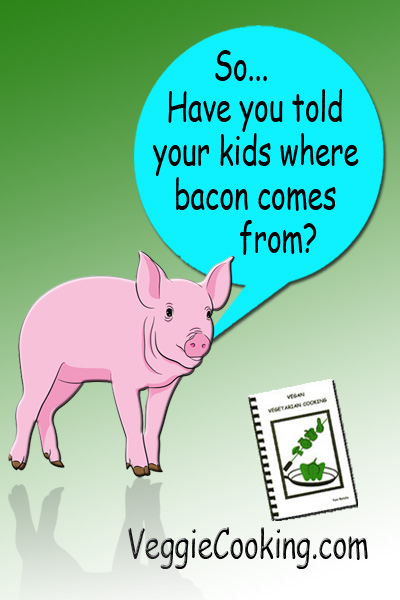 ADHD and the Feingold Diet, Joel Wallach, others
ADHD and the Feingold Diet, Joel Wallach, others
Hulda Clark and many others have offered their research findings on ADHD, commonly known as hyperactivity in children. ADHD is very controversial today, as so many children are medicated for the "disorder" with Ritalin, a drug similar to cocaine. Many consider ADHD to simply be natural behavior, with some children being more difficult to raise than others.
Dr. Joel Wallach wrote that ADHD is primarily found in children with a high-sugar diet, and in those who eat high-sugar natural foods as well, such as apple juice. Wallach claims that a mineral deficiency is also usually involved. Gary Null, the radio talk show host for "Natural Living", theorizes that ADHD is simply common problem behavior in children, and that the drugs used to control it can cause psychotic behavior, such drugs were even involved in school shootings. But by far, the most popular book on ADHD is the Feingold Diet. I've met parents who swear by the Feingold Diet, who won't let their children vary from it because they've seen the old symptoms return when they do. The Feingold Diet eliminates certain foods such as refined sugar, food dyes and colorings, and certain natural foods (such as apples) that can trigger ADHD symptoms. I'd assume that many of the recipes in my book would work well with the Feingold Diet, as most of my recipes have 100% natural, whole foods ingredients. However, as with any dietary plan, the reader should look at each recipe individually to see if it's appropriate.
The Atkins Diet
The Atkins Diet has been continually under attack since it became popular, from both the traditional and alternative medical fields. It is considered to be extremely unhealthy for a number of reasons. Basically, the diet works by depriving the body and brain of the sugars that it needs to survive, so in turn the body digests its own fat, muscles, and organs in order to make energy. Obviously, any recipes that are high in vegetables and low in carbohydrates might fit in with the Atkins Diet, but I'd prefer that my readers find a better diet than Atkins. Fit for Life was popular in the 1980's, and is still in print because it works so well.
My personal experience also goes against the Atkins Diet. There are many reports of Dr. Atkins' poor health before he died, being overweight and barely able to bend over. I can't verify those claims, although they did come from credible news sources. However, the Atkins Diet was very popular over the past few years, and I personally knew several people who used the diet. My Uncle David Johnson, a retired school principal, was told by his family doctor that he might feel a little better if he could lose some weight, and that maybe he should try the Atkins Diet. Uncle David did lose ten pounds on the diet right away, and felt so much better that he was starting to lose weight. . . and then he suddenly died of a massive heart attack, his first heart attack ever. I credit the Atkins Diet with killing my uncle-in-law. Then there are people I've worked with over the years who used Atkins. Every co-worker I've had who used the Atkins Diet claimed that it made them feel sick when they were on it, and that they couldn't stay on it very long. However, they're always going off and on the diet, because as soon as they go off of the diet, they gain the weight back, sometimes even more weight than they had before the diet. That's because diets don't work. Basic eating habits have to change in order to lose weight and keep it off. Going vegetarian might help, but for those hoping to seriously change their dietary habits, the book Fit for Life is a good start. Fit for Life teaches a principle called "Natural Hygiene", a way of eating that predates the book and includes proper food combining and working with the body's natural cycles of assimilation and elimination. I've known people who have lost over 20 lbs. in the first week using Fit for Life, just by following the "nothing but fresh fruit before noon" principle. Energy levels go up, not down, and the eating habits taught in the book can be followed indefinitely.
In essence, those wanting to follow the Atkins Diet should come back to my book after they're ready to get serious about dietary changes. Even if my book is somewhat compatible with Atkins, I don't recommend the Atkins Diet in any way, and hope that people will steer clear of it for the sake of their own health.
Vegetarian benefits in general
Obviously, my cookbook is vegan and therefore can give all of the health benefits that vegetarianism offers. Even better, my book is also a whole foods cookbook, working largely with fresh fruits and vegetables, so the reader can avoid most controversial food additives found in processed foods.
I've noticed that theories on cholesterol, blood pressure, and heart disease are constantly in flux. This is largely because pharmaceutical-funded studies are influenced by their funding sources' profit motives, and tend to conflict with studies funded by other sources. However, some fads come from alternative medicine as well, coming and going but not necessarily proven. For example many have attacked the causal link between high cholesterol diets and arteriosclerosis and heart disease, saying that a vitamin C deficiency or a chemical found only in red meats causes arteriosclerosis to develop. While funded science fights itself over their tainted results, and trendy theories of alternative medicine come and go, one thing remains the same -- that a vegetarian diet reduces the risk of heart disease and a number of other serious chronic diseases. Most of the other theories remain unproven, or fail people who believe and follow them, sometimes with tragic health consequences. But vegetarianism reducing the heart disease risk remains. That's one thing that any vegan cookbook can offer, especially one like mine, which avoids eggs, dairy products, and other risk factors like refined sugar and hydrogenated oils.
Upcoming changes
My book will go into its second printing soon, and I'm considering making some changes before then. I'd like to replace some of the simplest recipes with recipes that are a little more complex. I also may consider some of the major health theories mentioned above, for example proper food combining from Fit for Life or avoiding undercooked potatoes and a few other foods as Hulda Clark suggests. Most recipes would remain the same, of course, but I will consider replacing some and slightly changing others if I can make them more compatible with better health principles. I'll update this page when the re-write is complete and changes are finalized.
Until then, good health and happy eating!
Back to the top
© 2004 by Pam Rotella.
Back to Pam's vegan vegetarian FUN page
Pam's vegan vegetarian cookbook, with vegan vegetarian recipes
